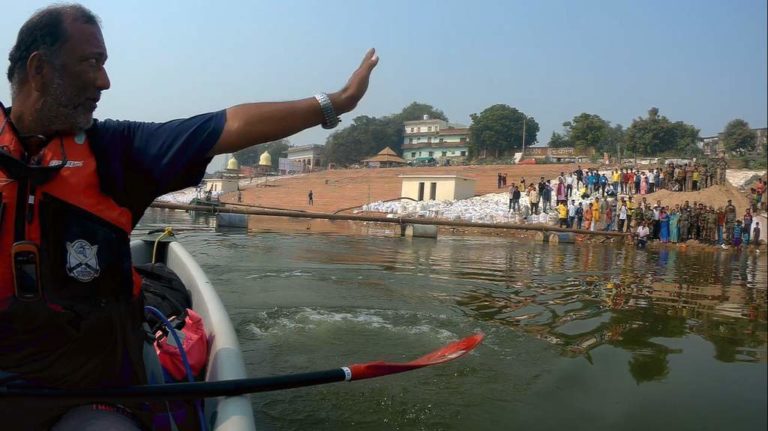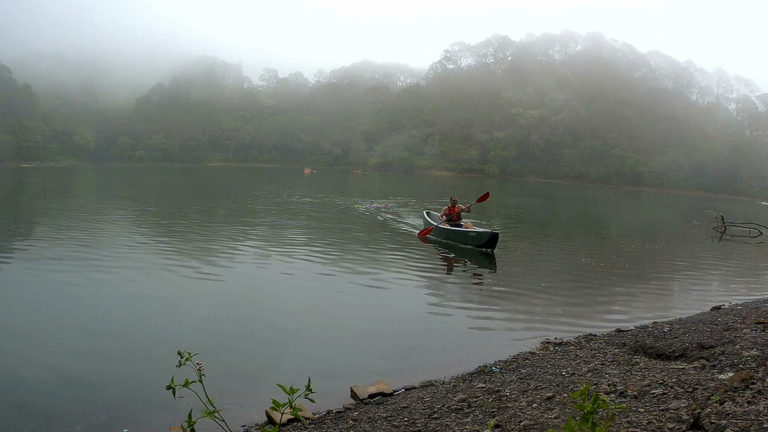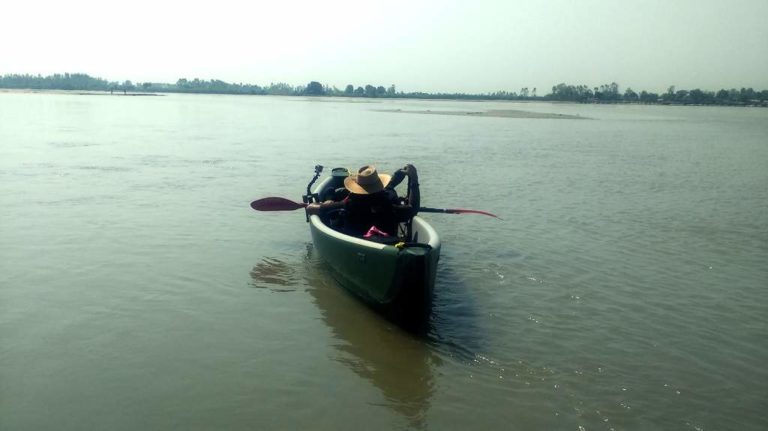Sep 04, 2018, D-minus-27

Slow Boat Down the Ganges Update 12
Now that Mr Gandhi is involved a little more directly in this expedition, let me take the opportunity to take a look at an initiative that has been taken by successive governments, but in a more aggressive way by the current government led by Mr Narendra Modi. The Swachh Bharat Mission. Also called the Swachh Bharat Mission or the Clean India Campaign.
The larger goal of the Mission is to clean up India and her roads, streets, cities, villages, infrastructure. But the more focussed goal is to eliminate open defecation by the time Gandhi’s birthday comes around in 2019, the 150th anniversary of his birth.
One major problem identified by the government, that has to be solved to attain the goal of a clean India, is to completely eradicate the reality of open defecation and turn India into a Open Defecation Free (ODF) country. A majority of Indians do not have access to a toilet, let alone a clean one, and thereby conduct the activity in the outdoors. Anyone who has travelled around in India, would have witnessed hundreds of people squatting in the fields, early in the morning, to answer Nature’s call. For women, it becomes not only a matter of dignity, but also of safety. Many girls drop out of school because the school does not have a toilet they can use.
Additionally, open defecation can pollute the environment and cause health problems. High levels of open defecation are linked to high child mortality, poor nutrition, poverty, and large disparities between rich and poor. Ending open defecation is an indicator being used to measure progress towards the Sustainable Development Goal Number 6 (one of the United Nations’ seventeen Sustainable Development Goals established in 2015). Extreme poverty and lack of sanitation are statistically linked. Therefore, eliminating open defecation is thought to be an important part of the effort to eliminate poverty.
The target of the Swachh Bharat Mission is to construct 90 million toilets around the country, particularly in rural India. A lot of effort and money has gone behind this project and a lot of people, celebrities and organisations have been co-opted to join the movement.
However, in India, open defecation in a centuries-old practice and requires a major behavioural change to make people understand and believe that using toilets is a better idea for their personal future, the future of their village and for the future of the country itself. It is a tough ask and may not be possible in a hurry. It might require a generation or two, increasing education, growing economic benefits, and visibly better health for people to realise this.
Despite the challenges, as per the data posted by the Ministry of Drinking Water and Sanitation (http://sbm.gov.in/sbmdashboard/Default.aspx, accessed on Sep 03, 2018), since October 2014, 83,190,380 household toilets have been built, 19 States, 443 districts, and 432,936 villages have been declared Open Defecation Free. Importantly, from A SLOW BOAT DOWN THE GANGES point of view, 4,465 villages have become Open Defecation Free as part of the Namami Gange project. These are villages that lie along the river, and 100% of the households in each of these villages now have a toilet.
This is very good news indeed and kudos to the government for having achieved this level of completion as far as open defecation is concerned. This will certainly go a long way in improving the health of the people as well as the health of the environment.
I will hopefully cross some of the villages listed on the government website as Open Defecation Free. It will be awesome to hear the before-and-after experiences of the citizens of these villages.
However, I want to look at this data with a caveat. When one says Open Defecation Free, does it mean that the residents in the area now have access to a toilet that they did not have before? Or is it that they have actually made the transition from defecating in the field, to using the toilet?
The other thing that trips up many initiatives is maintenance. India is a country where citizens are deeply steeped in caste and class boundaries. There are communities who have been manual scavengers for generations. It is this community that cleans the dry toilets of other communities who are considered superior. This because toilets are considered dirty and impure and anyone of a higher caste or class will not even think of cleaning a toilet. Which brings us to the question, who cleans these newly constructed toilets? Unless the toilets are maintained, the Mission will fail miserably and people will fall back on the excuse that these initiatives are bound to fail because of age-old prejudices and practices.
From the point of view of cleaning the Ganges, stopping people from defecating along the banks of the river, will certainly make it cleaner. However, the larger problem is the treatment and disposal of sewage. With the construction of toilets and without proper sewage treatment, the problem of pollution does not go away. Unless the individual household toilets are connected to a functioning sewage treatment plant, the problem of raw and untreated sewage flowing into the river will continue.
The National Mission for Clean Ganga (NMCG) has identified 97 towns in the five Ganga basin States of Uttarakhand, Uttar Pradesh, Bihar, Jharkhand and West Bengal which generate 3,603 MLD of sewage. The existing treatment capacity of the towns concerned is 1,584 MLD. An additional 89 sewage treatment projects have been taken up in 56 towns along the Ganga, estimated to create another 1,525 MLD capacity. These need to be operationalised quickly and it has to be ensured that they are maintained.
And here we are only talking about sewage, and have not talked about industrial effluents, which is another major, and probably more toxic pollutant that is raising a scare about the future health of the holy river. The government has and is cracking down on polluting industries, but it is again a question of implementation of the law and the setting up of effluent treatment plants.
The Swachh Bharat Mission is about a cleaner India. One of the first comments about India by almost any person, whether a citizen or a visitor, is the fact that it is dirty, it stinks, there are animals roaming the streets, dung everywhere, with people publicly pissing on walls with impunity. There is a lot that needs to corrected. Both from the infrastructure point of view, as well as from a behavioural point of view. Unless there are clean and accessible public toilets, people will continue to piss in public. But then, most (almost 100%) of the public urination is by men. Women seem to be able to control their urge much better. They will hold on till they find a public toilet they can use. If women can control their bodily urges, why can’t men? This is a behavioural change that needs to be inculcated in citizens.
One thing I find confusing about the Swachh Bharat Mission is the fact that the government levies a cess from the citizens. This cess is to create a corpus to help generate funds to make India clean. Unfortunately, in India labour is cheap. Most households, particularly those in the middle to upper middle class strata, have multiple people who are hired to do a multitude of household chores. Someone wipes the floors, another one does the dishes, yet another one washes the clothes, the dishes, waters the garden, looks after the infants, etc. With adequate disposable income, people find it quite easy to employ hired help, pay them the required money to do the chores they are supposed to perform.
By the same analogy, each citizen is paying money to the government in the form of a cess, so that the government can clean up India. This, to my mind, is akin to paying the hired help to sweep our floors. No master or mistress of the house would wipe the floors, when they are paying the hired help to do so. And that is what is wrong with the cess. If the government is taking money from the citizens, it is the government’s job to ensure a clean India, starting from the front of my house which is public property. To my mind, the government should have focussed on bringing about a behavioural change in the minds of citizens, ensure laws were in place, and make sure the laws were properly implemented.
There is a lot that is wrong with the country, yet there is so much potential in India and in Indians. If only the talent and the passion of being an Indian is harnessed and targeted towards a positive future, will India transform itself into Clean India, both literally and figuratively.
Talking of dirt, garbage, pollution, etc, I am really concerned about drinking water during this expedition. Till about Kanpur, I should be able to disinfect the water from Ganges with the devices I am carrying. The contaminants are largely bacteria and viruses. Coliform levels are very high in the river and hopefully my LifeSaver bottle will be able to remove them to make the water drinkable. However, this gadget does nothing to remove chemical pollutants from the water. There is no way I will be able to remove arsenic, lead, chromium, etc from the water. And there is a lot of it in the waters from Kanpur onwards. Even if I fill up my containers from wells, the water in the wells are seeping in from the river itself. The levels of heavy metals might be lower than what it is in the river, but they are surely there, and I do not wish to fill my body with those. Will I have to buy bottled water? Maybe. That is a call I need to take consciously when I reach areas that are known to be contaminated with heavy metals and chemical effluents.




 (3 votes, average: 5.00 out of 5)
(3 votes, average: 5.00 out of 5)![]()